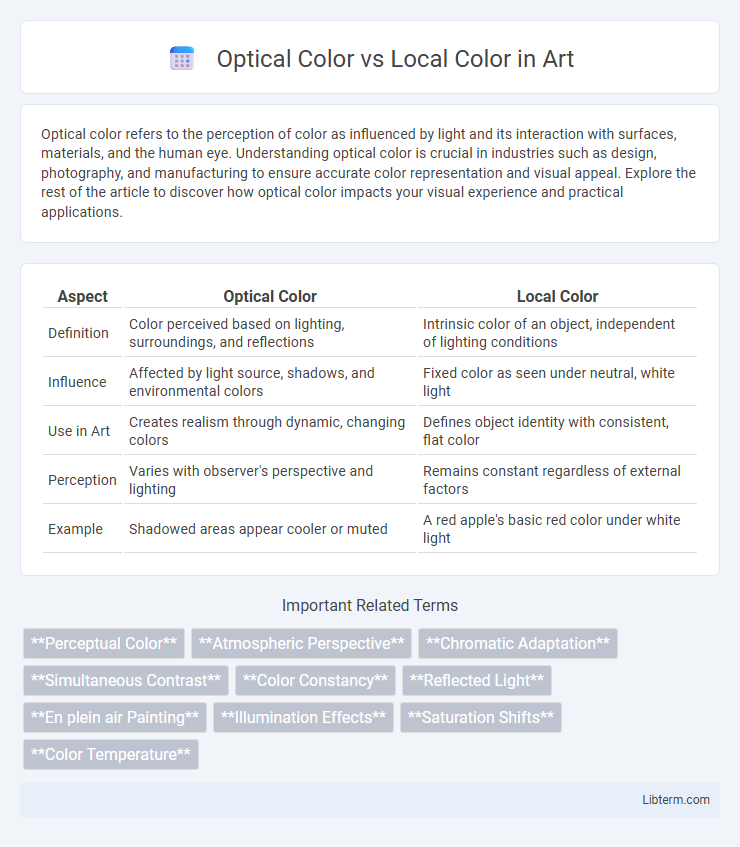Optical color refers to the perception of color as influenced by light and its interaction with surfaces, materials, and the human eye. Understanding optical color is crucial in industries such as design, photography, and manufacturing to ensure accurate color representation and visual appeal. Explore the rest of the article to discover how optical color impacts your visual experience and practical applications.
Table of Comparison
| Aspect | Optical Color | Local Color |
|---|---|---|
| Definition | Color perceived based on lighting, surroundings, and reflections | Intrinsic color of an object, independent of lighting conditions |
| Influence | Affected by light source, shadows, and environmental colors | Fixed color as seen under neutral, white light |
| Use in Art | Creates realism through dynamic, changing colors | Defines object identity with consistent, flat color |
| Perception | Varies with observer's perspective and lighting | Remains constant regardless of external factors |
| Example | Shadowed areas appear cooler or muted | A red apple's basic red color under white light |
Introduction to Optical Color and Local Color
Optical color refers to the perceived hue and tone of an object influenced by surrounding light and atmospheric conditions, changing with perspective and environment. Local color is the inherent, constant color of an object independent of lighting or shading effects, representing its true pigment. Understanding optical color helps artists and designers capture realistic visual experiences, while local color provides a baseline for accurate color representation.
Defining Optical Color
Optical color refers to the perceived hue created by the interaction of light, surface texture, and the observer's perspective, distinct from the inherent pigment or material color known as local color. It is influenced by lighting conditions, reflections, shadows, and atmospheric effects, resulting in color variations that change dynamically with the environment. Artists and designers leverage optical color to evoke realism and depth by capturing how light modifies local color in real-world scenes.
Understanding Local Color
Local color refers to the inherent, consistent color of an object as perceived under neutral lighting conditions, regardless of shadows or reflections. It represents the true pigment or surface color before external lighting effects influence its appearance. Understanding local color is crucial for accurate color rendering in art, design, and computer graphics, where it serves as the baseline for adjusting colors under varying illumination.
Historical Context: Color Perception in Art
Optical color emerged during the Impressionist movement in the late 19th century as artists like Claude Monet explored how light affects color perception by depicting shifting hues and shadows. Local color, rooted in classical art traditions, refers to the inherent, consistent color of objects regardless of lighting conditions, emphasizing stable representation. The historical shift from local to optical color marked a pivotal evolution in art, reflecting increased interest in sensory experience and the physics of light.
Key Differences Between Optical and Local Color
Optical color refers to the perceived hue influenced by lighting, shadows, and surrounding colors, while local color remains constant and denotes the true color of an object regardless of lighting conditions. Optical color changes based on environmental factors and viewer perspective, impacting visual realism in art and photography. Local color serves as the baseline color for objects, essential for color correction and maintaining color accuracy in digital imaging and design.
Role in Impressionism and Modern Art
Optical color, which relies on the interaction of light and perception, plays a crucial role in Impressionism by capturing the fleeting effects of sunlight and atmosphere, as seen in Monet's use of broken brushstrokes and vibrant hues. Local color, the inherent color of objects regardless of lighting, grounds the composition but is often subverted in modern art to emphasize emotional or conceptual interpretations, as demonstrated in works by Cezanne and Matisse. The distinction between optical and local color highlights a shift from realism to expressive abstraction in the evolution of modern art.
Techniques for Using Optical Color
Optical color techniques leverage the interaction of light and surrounding hues to create vibrant visual effects, often achieved through methods like color juxtaposition and simultaneous contrast. Artists apply tiny dots or strokes of pure color side by side to stimulate the eye's perception of new hues, a technique prominent in Pointillism. This approach enhances luminosity and depth by relying on the viewer's optical mixing rather than physical paint blending.
Techniques for Depicting Local Color
Techniques for depicting local color emphasize capturing the inherent hues of objects unaffected by lighting conditions, using flat washes, pure pigments, and consistent tonal values to maintain color fidelity. Artists often employ direct observation and color matching to represent the subject's true color, avoiding shadows or highlights that alter perception. This approach contrasts with optical color, where the interplay of light and atmosphere dynamically shifts hues and requires blending and modulation for realism.
Impact on Mood and Visual Realism
Optical color, influenced by lighting and environmental context, enhances mood by creating dynamic visual experiences that evoke emotional responses through subtle light and shadow interplay. Local color represents the inherent color of an object under neutral lighting conditions, providing consistent visual realism but often lacks emotional depth or atmospheric variation. Understanding the distinction between optical and local color is essential in art and design to balance accurate representation with mood-driven visual storytelling.
Choosing Between Optical and Local Color in Your Artwork
Choosing between optical color and local color in your artwork hinges on the desired visual effect and emotional impact. Optical color captures the way light, atmosphere, and surrounding hues influence an object's appearance, creating a dynamic and realistic representation. Local color focuses on the object's inherent, unchanging hue, providing clarity and simplicity by emphasizing its true color regardless of environmental changes.
Optical Color Infographic

 libterm.com
libterm.com